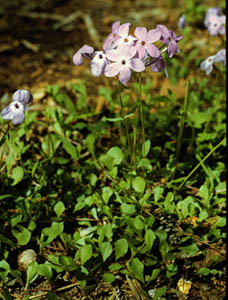Phlox stolonifera
Creeping phlox
Elizabeth Tyler
University of Georgia
etyler@arches.uga.edu
Authorities: First named by Sims. Recent taxonomy on the
family Polemoniaceae by Grant.
Photograph courtesy of Univ. of Georgia Herbarium.
Copyright Dept. of Botany, Univ. of Georgia, Athens. All rights reserved.
Index:
Taxonomy
Kindom: Plantae
Division: Embryophyta
Subdivision: Phanaerogama
Branch: Angiospermae
Class: Dicotyledonea
Order: Polemoniales
| Family: Polemoniaceae
Subfamily: Polemonioidea
Tribe: Polemoniacea
Genus: Phlox
Species: stolonifera
|
Geography and Distribution
Phlox stolonifera is native to the rich, damp woods of
the Appalachian Mountains and the Piedmont. It is found
throughout the United States and in Southern parts of Canada, but is most
prevalant in the Eastern United States.

Identification
The family Polemoniaceae is distinguished from other dicots by a
three-carpellary ovary.
Other characteristics include:
- Annual or perennial herbs
- Bisexual
- Regular or irregular flowers
- Tubular corolla of 5 united, radially symmetric petals
- Sepals are united in a tubular calyx
- 5 stamen, 3 united carpels
- One style and a 3-lobed stigma
- Nectar is produced by a disk surrounding the ovary and it collects
in the base of the corolla tube
- Abundant endosperm
- Fruit is a capsule
- Flowers are sympetalous and hypogynous
Characteristics of Phlox:
- Annual or perennial herbs
- Alternate or opposite leaves without stipules
- Regular hypogynous
Features of stolonifera:
- Low-growing perennial herb
- Broad oval leaves covered with downy hairs
- Usually purplish-blue flowers, but occassionally white, that shoot 15 to 25 centimeters high
- Leaves
- On sterile shoots
- Obovate to oblanceolate
- Long, coarse-ciliate petiole
- Blade up to 45 mm long and
18 mm wide
- On flowering shoots
- Oblong to ovate and half as large
- Sessile
- Sepals
- 9 to 11 mm long and united about half of their length
- Blade is
linear-subulate, cuspidate
- Corolla-tube
- 21 to 25 mm long
- Pilose with gland-tipped hairs
-
Petal-blade obovate and around 14 by 9 mm
- Inflorescence is unorganized, but usually
of around 6 flowers
- Styles are 20 to 24 mm long
Type specimens: A plate and description by Sims of a clone collected
in Georgia in 1786 by John Fraser. I could not find its current location.
See
Picture 1 and Picture 2
Natural History and Ecological Requirements
Phlox stolonifera requires shade to light sun and a slightly acidic soil (pH 5.5 to 7).
They are heavy feeders, therefore they thrive in woodland areas with moist soil rich in organic
matter. They grow 8 to 18 inches high and 8 to 12 inches wide. Five cultivars of Phlox
stolonifera are described here.
Seasonal Activity: Phlox stolonifera blooms in early spring to early summer. They are mostly
violet and give off a honeysuckle-like fragrance.
Pollination: This flower is a cross-fertilizing perennial herb with salverform flowers that are
pollinated by Lepidoptera (butterflies). The stamen is on the lower side of a broad corolla throat
and nectar is concealed in a short tube below the throat. The salverform corolla has a long, slender
nectar tube and a sweet fragrance.
References:
Bailey, Liberty Hyde and Ethel Zoe Bailey, Hortus Third.
Macmillan Publishing Company, Inc., New York, 1976.
Everett, Thomas, The New York Botanical Garden Ilustrated Encyclopedia of Horticulture.
Garland Publishing, New York, 1981.
Grant, Verne, "Primary Classification and Phylogeny of the Polemoniaceae, with Comments on Molecular
Cladistics." American Journal of Botany. 85: 741-752, 1998.
Grant, Verne, and Karen A. Grant, Pollination in the Phlox Family. Columbia University
Press, New York, 1965.
Hickey, Michael and Clive King, 100 Families of Flowering Plants.
Cambridge University Press, Cambridge, 1988.
Porter, C.L., Taxonomy of Flowering Plants. Freeman and Company, San Francisco, 1967.
Wherry, Edgar T., The Genus Phlox. Associates of the Morris Arboretum, Pennsylvania, 1955.
http://
www.jcsolutions.com/jcsgrower/perenphlox.htm
http://www.uvm.edu/
-pass/perry/feb97per.html
http://wwwstd.enmu.edu
/volkm/index5.htm
http://www.czguest.com/docs/articles/summer_nyp/nyp060897.html

